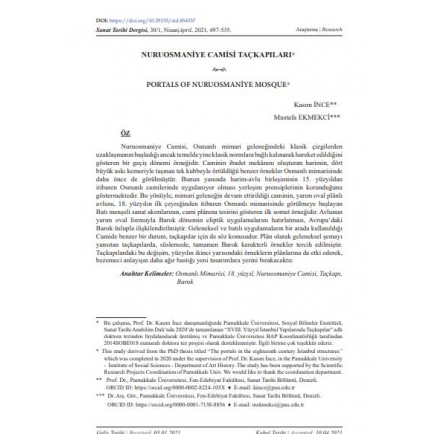
PORTALS OF NURUOSMANİYE MOSQUE
Date Added
01/07/2022
Content Type
Documentary
Category
Researches
Link to Content
Subject Area
Mosques
Author
Mustafa Ekmekci
Publisher Name
Sanat Tarihi Dergisi
Year of Publication
2020
Description
Nuruosmaniye Mosque, which was beginning to be built by the order of Sultan
Mahmud I’s order and completed after his death by his brother Sultan Osman III, is the
most important building of Ottoman Westernization Period architecture. Architects of the
complex, which includes a mosque, a sultan’s pavilion, a madrasa, a library, a tomb, a sebil,
a fountain, an imaret, and shops, are Mustafa Agha and his aide Simeon Kalfa. The mosque
has a planning scheme formed by the square-planned prayer area covered with a single
dome, the polygonal mihrab projection on the south wall, and the semi-oval courtyard
to the north. The traditional scheme imposed on the main body of the mosque and the
Baroque effect on the mihrab and courtyard wall; make the mosque an example that shows
traditional and westerner applications together. Nuruosmaniye Mosque is a transition era
example that started moving away from classical lines of Ottoman architectural tradition yet
abide by classical norms. The architectural design of the praying area consists of a square
planned section covered by a single dome carried by four great arches that had been seen
in Ottoman architecture before. Moreover, the implementation of merging the praying zone
with the courtyard since the 15th century shows that settlement principles were maintained.
From this aspect, while the mosque continues to reflect the traditional architecture, the
semi-elliptical planned courtyard of the mosque is the first concrete example of how
art movements originated in the West from the first quarter of the 18th century onwards
affected mosque plans. The semi-elliptical form of the courtyard that reminds the elliptical
implementations of the Baroque era has been related to the Baroque style in Europe.
A similar situation was observed on the portals of the mosque in which traditional and
western practices are used together. While portals reflect the traditional scheme in planning,
baroque characters are exclusively preferred in ornaments. The traditional scheme which
was constituted with side niches located on both sides of the side wings and the intrados of
the main niche is continued to be used. Although the plan is traditional, usage of baroque
style ornaments solely shows that classical and western implementations were evaluated
together. Horizontal moldings filled with baroque style ornamentations replaced intrados
filled with muqarnas. This innovation seen in decoration shows itself in the context of
architectural elements in the replacement of small columns by plasters corners on side
niches of the main niche. Especially preferring not to place the main niche on the design of
the inner court northern-side portal is a clear sign of change in the portal plans. In addition,
placing independent decorative columns on the front side of the same portal shows that it
had been influential on the other selatin mosques built after Nuruosmaniye Mosque. This
change and transformation regarding portal designs and plans tell us that portals in Ottoman
architecture were continued to be designed and implemented as they were treated in
traditional styles until Ottomans meet western affected art movements. The aforementioned
alterations started with Nuruosmaniye Mosque would affect other examples in the second
half of the century and give a place to designs with more ornamental styles.





